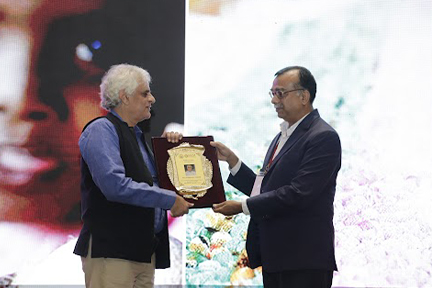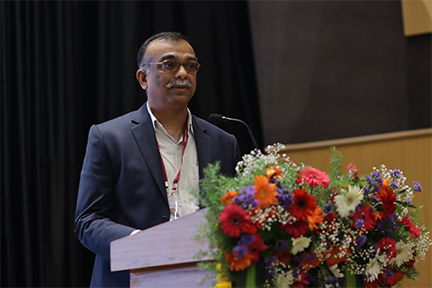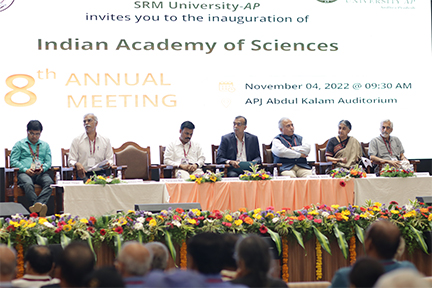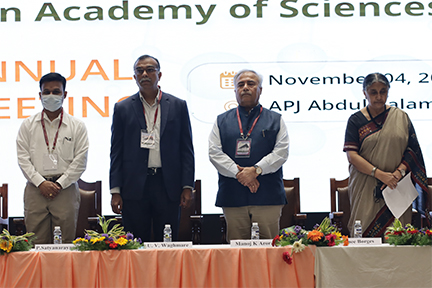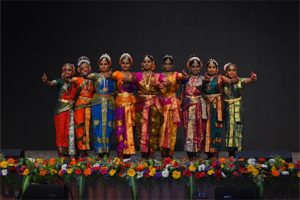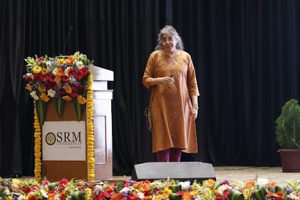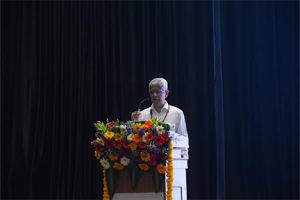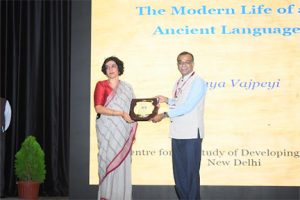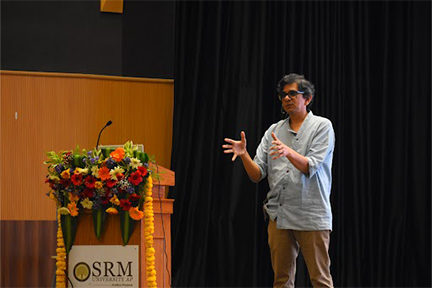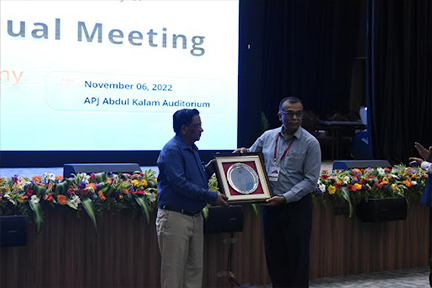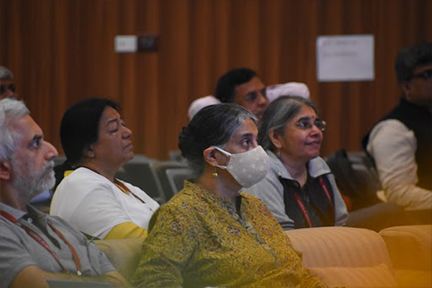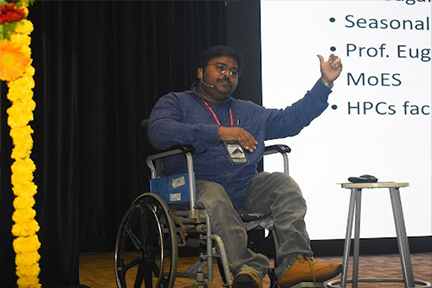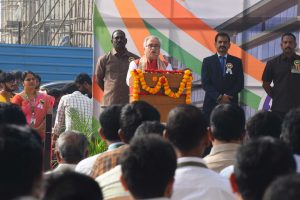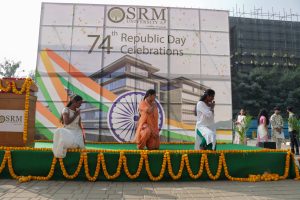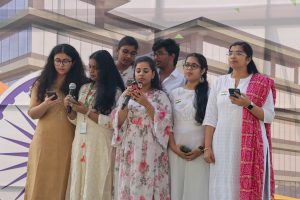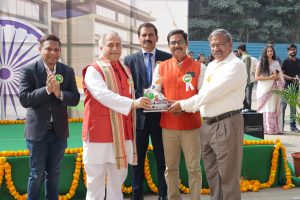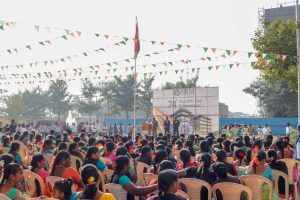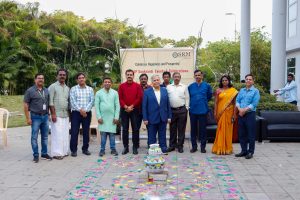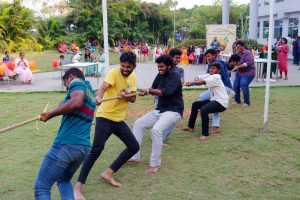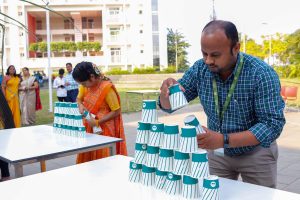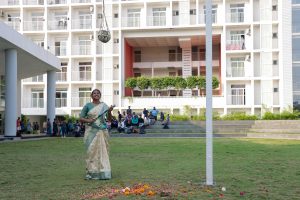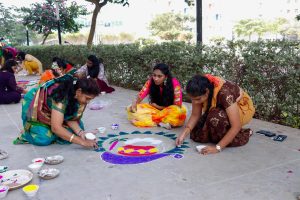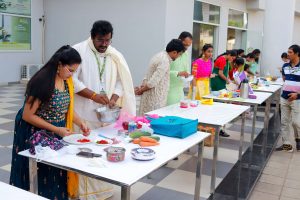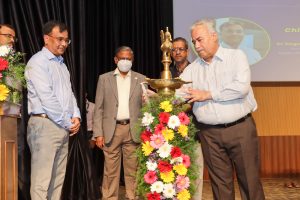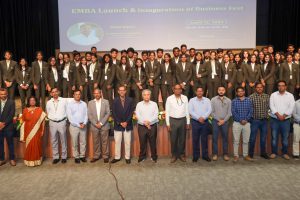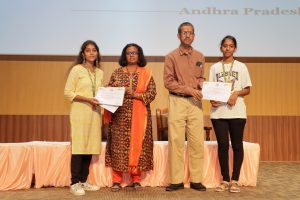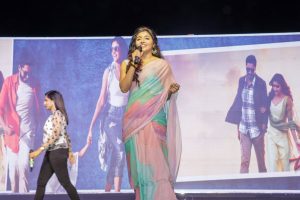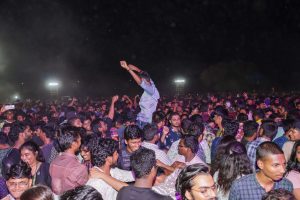88th Annual Meeting of Indian Academy of Sciences begins at SRM University-AP
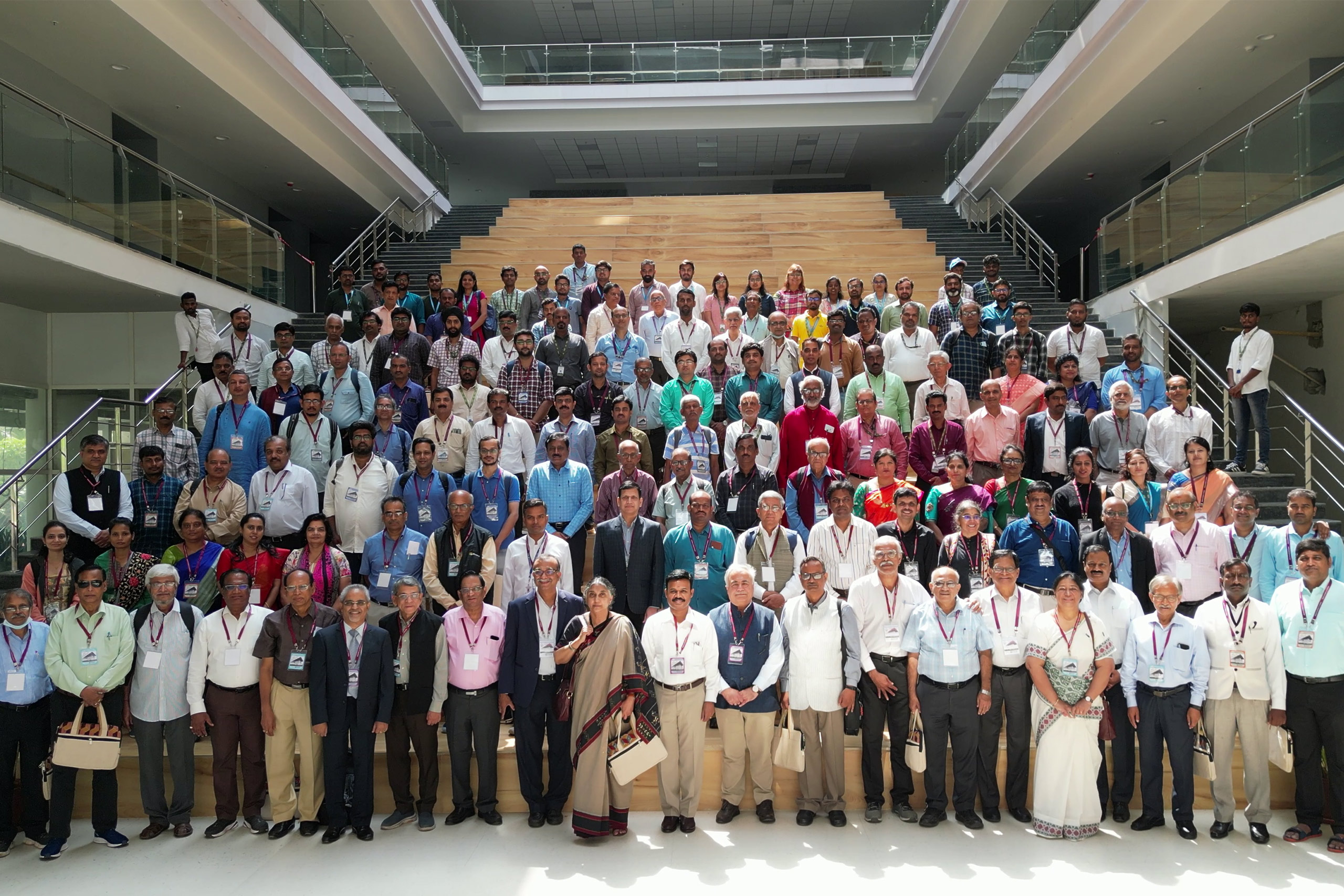
The 88th Annual Meeting of the Indian Academy of Sciences began on Friday, November 04, 2022, at SRM University- AP. The event, which spans three days, features distinguished fellows and associates of IASc and renowned Professors from premier institutions across the country. Prof. Umesh V Waghmare, President of the Indian Academy of Sciences, inaugurated the Annual Meeting with his presidential address on “Instabilities of crystals and their functional properties”.
Prof. Waghmare’s lecture revolved around the usage of fundamental laws of Physics in identifying instabilities in crystals. It also acquainted the audience with how these fundamental concepts hold supreme importance in the development of predictive models that capture interactions between the instabilities and external forces to predict the material-specific functional behaviour of advanced materials. The noteworthy remarks were Illustrated with crystal instabilities of polar phonons, spin-ordering, and strain that drive the functional properties of ferroelectrics, antiferromagnets, and shape memory alloys, respectively.
In his welcome speech, Prof Manoj K Arora, Vice-chancellor of SRM University- AP, requested the fellow and associate members of IASc to encourage and instil their unwavering admiration and inclination for research and development into the faculty of educational institutions. He also expressed his concerns about how science and technology are instructed to students in classrooms; considering the enthusiasm and genuine yearning for innovations; it should evoke among students to retain the potential for constructive explorations in ages to come.
“The things that kept an organisation like ISRO going beyond human imaginations and expectations is the solemn belief in themselves, the teamwork and the right sublime combination of the wisdom of past generations and the innovative outlook of the young generation”, stated Prof D Narayana Rao as he expressed his immense acclamation towards the institutes that constitute to the research and development of the country. He also asserted why discovering basic science matters or should be appreciated as they might get transformed into the theories of tomorrow. He also added that the scientific community is destined to live up to the responsibility and highlighted the need to upgrade intellectual and material prosperity. He also emphasised that educational institutions are the backbone of research and development in a country, and there are eccentric career opportunities for the youth in the coming years.
Pro-Chancellor of SRM University- AP, Dr P Sathyanarayanan, thanked IASc for believing in the university’s calibre to be a host and a part of the initiative. He said that he is expecting around 10000 students to benefit from the event. Furthermore, he elaborated on the potential of industry and academia coming together for the improvement of research and development of the country.
The inauguration was followed by a special lecture on “Uniqueness of plant mitochondria: Relevance to crop improvement and climate change” by A S Raghavendra, University of Hyderabad. Swagata Gupta from IIT Kharagpur chaired the lecture. The session concentrated on the distinct features of plant mitochondria that set them apart from animal mitochondria. The speaker elaborated on how mitochondrial metabolism can help plants to adapt to climate changes in terms of flooding, global warming, and elevated CO2.
Afternoon sessions started with lectures by fellows and associates and were chaired by K Bhanu Sankara Rao, University of Hyderabad. The first lecture by Dr D B Ramachary, University of Hyderabad, on the “Discovery of sustainable organocatalytic reactions: Expansion of substrate/catalysts scope”. Discussed the discovery of in-situ generated novel reactive primary catalytic species. The session also focused on their direct applications in a variety of selective green bond formations to furnish the chiral functionalised molecules, drugs, drug-like molecules, natural products, and pharmaceuticals. The second speaker Aditya Bandyopadhyay from IIT Kharagpur talked about “Electrified fluid interfaces- Waves and pattern formation”. He detailed how Interactions of electric fields at the interface of two fluids can lead to particle agglomeration at interfaces, as applied to DNA motion at the interface of two aqueous solutions.
The second speaker Aditya Bandyopadhyay from IIT Kharagpur talked about “Electrified fluid interfaces- Waves and pattern formation”. He detailed how Interactions of electric fields at the interface of two fluids can lead to particle agglomeration at interfaces, as applied to DNA motion at the interface of two aqueous solutions.
The special lecture was followed by a Symposium on Green energy. Dr Ranjit Thapa, Associate Dean- Sciences, SRM University- AP, introduced the symposium that provided a deep understanding of hydrogen generation, hydrogen fuel cells, and beyond hydrogen. Dr Ashok K Ganguli, IIT, New Delhi, handled the first session of the symposium on “Photoelectrochemical water splitting for green energy”. The key process of converting water into clean and renewable hydrogen fuel by using highly efficient photocatalysis was discussed. Furthermore, the session also underlined the growing interest in suitable semiconductor materials as photocatalysts for efficient photoelectrochemical water-splitting applications. The transformation needed to achieve the goals of the Paris agreement, the necessity of renewable energy, the difference between clean, green, and renewable energy, photocatalysis, and many more interesting areas were covered during the lecture. The next lecture on “Low-carbon biohydrogen: Enabling through biorefinery” was delivered by S Venkata Mohan, IICT Hyderabad, and was followed by another talk on “Electrochemical energy systems: Hydrogen generation and its use in fuel cells” by S Sampath, IISc, Bengaluru. The symposium came to a close with the lecture of Ramendra Sundar Dey, Institute of NanoScience &Technology, Mohali, on “Electrochemical nitrogen reduction reaction for the synthesis of ammonia: A pathway to a green future”.
All the sessions were followed by meaningful discussions and dialogues with distinguished participants. IASc Secretaries Prof Renees Borges, Prof. Vijay Mohanan Pillai, Treasurer Raghunathan V A and many other dignitaries from the Indian Academy of Sciences, Bengaluru and SRM University-AP, Andhra Pradesh, were present at the sessions.
- Published in News, University Event
The second day of 88th Annual Meeting of Indian Academy of Sciences at SRM University- AP

The second day of the 88th Annual Meeting of the Indian Academy of Sciences held at SRM University- AP on Saturday, November 05, 2022, continued to behold the momentum of the first day of the gathering. The highlights of the day were the Lectures by fellows and associates, a Symposium on “Floods in the Anthropocene,” and a public lecture on “The Modern Life of an Ancient Language” by Ananya Vajpeyi, Centre for The Study of Developing Societies, New Delhi.
The first session in the morning, lectures by fellows and associates, was chaired by G V Anand, Dayanand Sagar University, Bengaluru. The series of lectures commenced with a talk on “The Novel (IZ4) spreading code design for NavIC’s LISPS signal” by P Vijay Kumar, IISc, Bengaluru. The lecture focused on the NAVigation with Indian Constellation (NavIC), an indigenous regional navigation satellite system developed by ISRO, and other related topics.
Anil K Tripathi, BHU, Varanasi, did the second lecture on the “Regulatory cascades of alternative sigma factors are involved in controlling rhizocompetence in a plant growth promoting rhizobacterium, Azospirillum brasilense.” The lecture focused on Azospirillum brasilense, one of the most ubiquitous plant growth-promoting rhizobacteria, which can sense and detoxify Reactive Oxygen Species (ROS) released by plants. Furthermore, the talk proceeded to discuss how bacteria respond to changes in their internal and external environment by expressing genes needed to cope with the challenges of the altered environment. The session elaborated on the changes faced in the root zone, the rizhocompitance of plants, the fundamental ways in which the roots respond to changes happening in the roots, the effect of stigma factors, and many more.
Atul Geol, CORI, Lucknow, did his lecture on “Development of donor-acceptor-based fluorescent dyes for diagnostics and biomedical applications.” He detailed the pioneered breakthrough innovations of basic building blocks for synthesising TAQMAN-like probes and alternate conjugation chemistry to develop complete RT-PCR kits for detecting SARS-CoV-2 variants. He also expressed how his team is engaged in developing efficient approaches for synthesising new organic fluorescent dyes with absorption and emission at various wavelengths for biomedical and diagnostics applications.
The Development origins of Health and diseases (DOHaD)) hypothesis suggests that early life exposure, including maternal nutrition and phenotype, can predict the risk of non-communicable diseases (NCDs). The session on “Early life exposure and future risk of non-communicable diseases: Relevance in the Indian context” by GR Chandak, CCMB, Hyderabad, elaborated this hypothesis furthermore. It explained the dissection of gene-gene and gene-environment interaction that can predict the future risk of NCDs.
The lectures by fellows and associates were succeeded by a symposium on “Floods in the Anthropocene.” Introduction to this exciting session was done by the Convener Pradeep P Mujumdar, IISc Bengaluru. He provided an overall idea regarding the title of the symposium. He reflected on the ecological and geographical aspects of the topic. He talked a bit about the repeating patterns of floods, the changing frequency of rains, the effect of reservoir operation on floods, etc.
Rajiv Sinha from IIT, Kanpur, was the first to deliver a lecture in this session and was on the “Hydrogeomorphology and sediment dynamics of floods.” He explained that there are particular settings where floods occur more frequently than in other riverbeds and stated that understanding this can help predict the potential sites of floods. The session discussed relevant topics such as the worldwide distribution of floods, Floods in large rivers, Natural or human-induced reasons for floods, Rivers in the Anthropocene concerning specific reference to flood hazards, geomorphology of rivers, floods, and sediment dynamics, dynamic flood topography and many more. The session also put a thought upon the false sense of security while living close to larger rivers that eventually result in irreversible loss. Moreover, he introduced the idea of integrating river morphology into flood management.
The topic “Extreme precipitation under human-induced climate change” was handled by Subimal Ghosh, IIT, Mumbai. Spatial and temporal resolutions of rainfall, extreme precipitation, thermodynamic and dynamic contributions to changing precipitation, atmospheric instability and precipitation, future changes in different warming levels, impacts of urbanisation, and many other topics were under discussion.
The next session on “Deciphering the role of climate change in floods” by Arpita Mondal, IIT Mumbai, explained how a once-in-a-thousand-year event, flood, became a once-in-10-years event with a detailed analysis of the recent flood emergencies occurred in India. She also stressed the attribution analysis of floods, anthropologic climate change, Spatio-temporal scales to define the event, and many other areas.
The last speaker of the symposium was J Indu, IIT Mumbai, and was centered around the topic “Floods from the vantage point of Radars.” She started the lecture by questioning the inaccuracy of observing precipitation from satellites for examinations. She also inspected the network of weather radars, forecasting using radar-based rainfalls, the time limit of radar data assimilation, etc. The symposium came to an end with an exciting interactive session that raised numerous constructive queries and composed a space for incredible engagement.
The afternoon sessions started with lectures by fellows and associates, and C Pulla Rao from IIT Tirupati served as the chairperson of the series of lectures. “Distinguished varieties in the polydisc and dilation of commuting matrices” by Sourav Pal, IIT Mumbai, set the start of the lectures.
Binod Sreenivasan, IISc Bengaluru, was in charge of the next session on “Understanding Earth’s magnetic reversals.” He conferred about one of the long-standing questions in dynamo theory: whether the preference for the axial dipole is due to a purely hydrodynamic process influenced by planetary rotation or due to a magnetohydrodynamic process influenced by both rotation and the self-generated magnetic field.
The talk “You are what you eat: linking metabolism to physiology & health” by Ullas K Seetharam, TIFR Mumbai, put forward the importance of discovering or understanding diet or metabolism-driven mechanisms that govern psychological homeostasis to tackle the explosive burden of non-communicable diseases.
The session ended with Meena B Mahajan, IMSc Chennai, through her lecture on “What is hard to prove, and why?”. She instructed formal proofs, the design of formal proof systems and demonstrated its limitations.
- Published in News, University Event
The finale of the 88th Annual Meeting of Indian Academy of Sciences at SRM University- AP
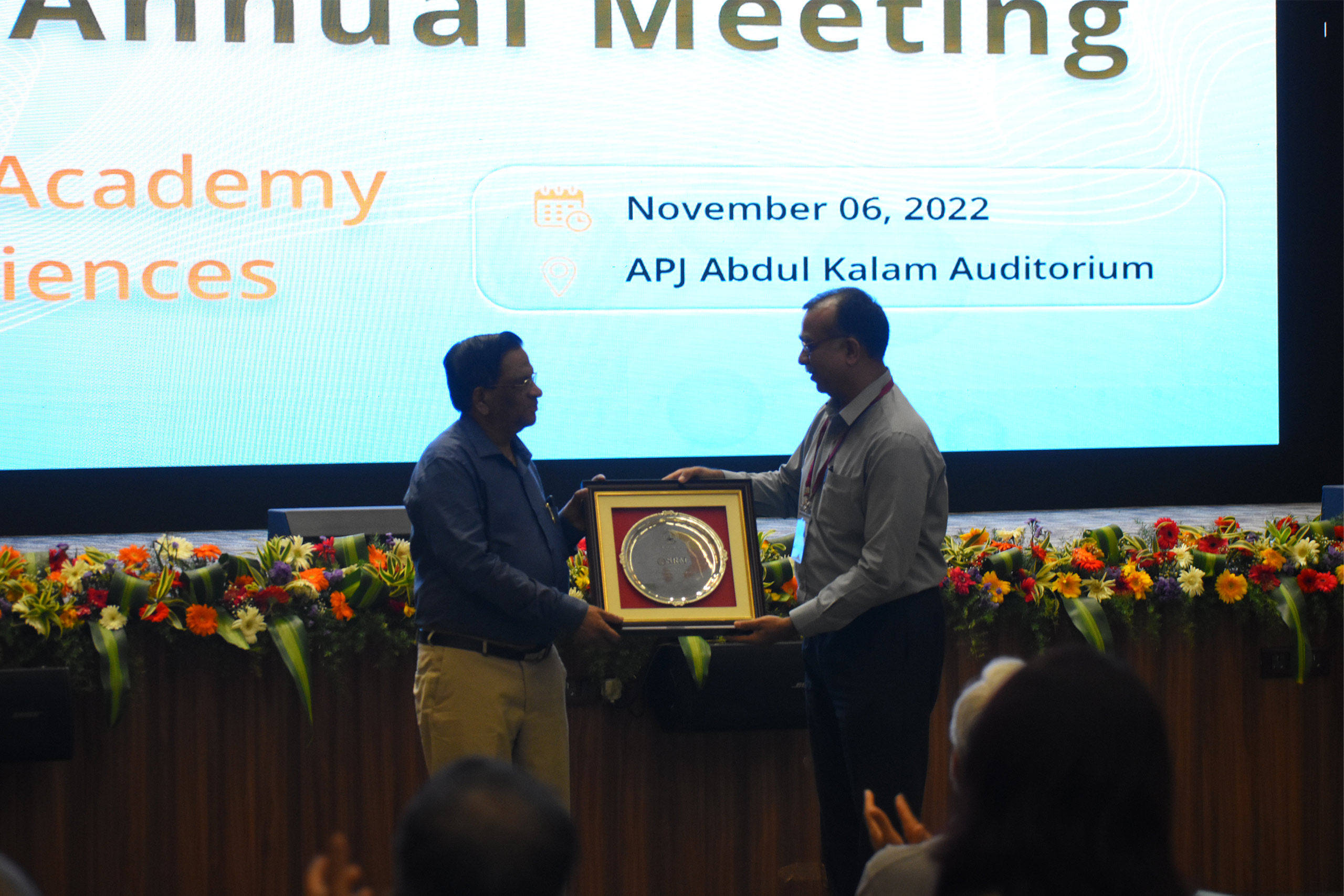
The three-day-long 88th Annual Meeting of the Indian Academy of Sciences came to an end at SRM University- AP on November 06, 2022. On the final day of the Meeting, Dr Swapan K Ghosh, University of Mumbai, chaired the first set of Lectures by Fellows/Associates Dr Prabhat Mandal, SN Bose National Centre for Basic Sciences, Kolkata; Dr Jitendra K Bera, IIT, Kanpur and Dr P Sreenivas, University of Hyderabad, were the speakers.
Dr Pranab Mandal spoke on the topic “A new paradigm for understanding solids”. He briefly discussed the conventional electronic states, which have been realised in the band theory of solids. The theoretical foundation and experimental realisation of topological electronic states in several condensed matter systems were also covered in the lecture.
“Water as a reactant in organometallic catalysis” was the topic presented by Dr Jitendra K Bera. The talk focused on the hydration of nitriles and alkynes, olefin oxygenation, alcohol oxidation to acid, and oxidative deamination of primary amines using water.
The last speaker of the session was Dr P Sreenivas, and he dealt with the topic “An advanced Ensemble Kalman Filter based ocean-atmospheric coupled data assimilation system and its impact in enhancing the Indian monsoon predictions”. He elaborated on how the new system incorporates theoretically advanced features of flow-dependency and ensemble-based analysis, and the predictions using the new system simulate the large-scale monsoon features and convection canters well and improves Indian Summer-monsoon-rainfall prediction skill with a gain of one month lead time.
Dr A Jayaraman, Bangalore University, Bengaluru, was the Chairperson to the lectures by Dr Suchana Taral, Pondicherry University, Puducherry; Dr Gobardhan Das, JNU, New Delhi and Dr Sneha Sagarkar, SP Pune University.
Dr Suchana Taral’s talk was on “Source-to-sink pathway of the Himalayan sediments: New evidence from the eastern Himalayan foreland”. In the lecture, she proposed a new model for the evolution of the eastern foreland basin, taking into account the hierarchical stratigraphic response to eustatic and tectonic forcing.
“Mycobacterium Tuberculosis programs mesenchymal stem cells to establish dormancy and persistence” was the topic presented by Dr Gobardhan Das. He explained that Tuberculosis treatment displays a biphasic bacterial clearance, in which the majority of bacteria clear within the first month of treatment, but residual bacteria remain nonresponsive to treatment and eventually may become resistant. Then he proceeded to show that Mycobacterium Tuberculosis was taken up by mesenchymal stem cells (MSCs), where it established dormancy and became highly nonresponsive to isoniazid, a major constituent of directly observed treatment short course (DOTS).
Dr Sneha Sagarkar talked about “Reward memory recall: Role of Glutamatergic Neurotransmission in the dentate gyrus”. She explained why the reward association process is critical for memory-guided decision-making that deteriorates mental illnesses such as binge eating disorders (BED), drug addiction, and schizophrenia.
The Special Lecture titled “Nobel Prize for Physics 2022: From Foundational Questions in Quantum Physics to Cutting Edge of Today” by Sadiqali Rangwala, RRI, Bengaluru, had V A Raghunathan, RRI, Bengaluru as the chairperson. He discussed the physics problems from first principles and highlighted how the pathbreaking experiments were done, which led to the Nobel Prize.
In the Public Lecture titled “The Modern Life of an Ancient Language”, Dr Ananya Vajpeyi from the Centre for the Study of Developing Societies, New Delhi, revisited the history of Sanskrit in modern times. According to the speaker, Sanskrit finds new life and meaning in a world shaped by nationalism, science, and struggles over identity. Vibrant cultural programmes by the students of SRM AP were also organised as a part of the 4-day long celebration of Science and Technology on campus. IASc President Prof Umesh Waghmare felicitated SRM AP Pro Vice-Chancellor Prof D Narayana Rao for successfully hosting the 88th Annual Meeting of the Academy.
- Published in News, University Event
SRM University- AP hosted the Science and Technology Exhibition of ISRO&DAE
SRM University-AP hosted the Science and Technology Exhibition organised by ISRO & DAE from November 03-06, 2022, as a part of the 88th Annual Meeting of the Indian Academy of Sciences, Bengaluru. The exhibition laid the foundation for scientific discourse in recent developments in nuclear tech, space tech and rocket science. Modern research models and detailed exhibition panels arranged at the tech venue, engaged students with the latest research technologies.
The scientific convention witnessed a prolific participation from school students from the regional locale with almost 20,000 students from various schools like Delhi Public School, S.T.B.E.M. High School etc. attending the event. Students had the opportunity to associate with renowned scholars and researchers and experience the technological advancements in ISRO & DAE space and nuclear tech. They were free to explore the exhibitions under the guidance of student volunteers of SRM AP.
The ISRO exhibition, inaugurated by the Honourable Governor of Andhra Pradesh, Shri Biswabhusan Harichandan, showcased prototypes of satellites/vehicles with a detailed description on their conception, manufacturing and working principles. Exhaustive exhibition panels displayed information on breakthrough space ventures including the Gaganyaan Mission, Mars Orbiter Mission and many others. Chanda, a 9th grader from DPS, commented that she was ecstatic to visit the exhibition and the campus. The young space enthusiast utilised this opportunity to learn about the different models and their application and vocalised her desire to become the next Kalpana Chawala.
Demonstration models illustrating novel nuclear tech and atomic models were the highlights of the DAE exhibition. Followed by the inauguration, the exhibited prototypes were briefly explained by Jalaja Madan Mohan, Head Technical Co-ordinator & Public Awareness Section, IGCAR, DAE to the Honourable Governor and other dignitaries visiting the exhibition. The DAE exhibition provided an incredible opportunity for young students and researchers to explore the evolving domain of atomic and nuclear science.
The enthusiastic and active participation of students were graciously welcomed by Pro Chancellor of SRM AP, Dr P Sathyanarayanan, Vice Chancellor, Prof Manoj K Arora, and Pro Vice Chancellor, Prof D Narayana Rao. The students were dispensed with knowledge about modern technologies and research fields to promote research interest for the progress of society. They were also made aware of the growing career opportunities in the reputed organisations of ISRO & DAE. Lunch followed by a tour of the campus acquainting them with the state-of-the-art facilities were also provided.
- Published in News, University Event
The prevalence of digital divide and agrarian crisis in rural India
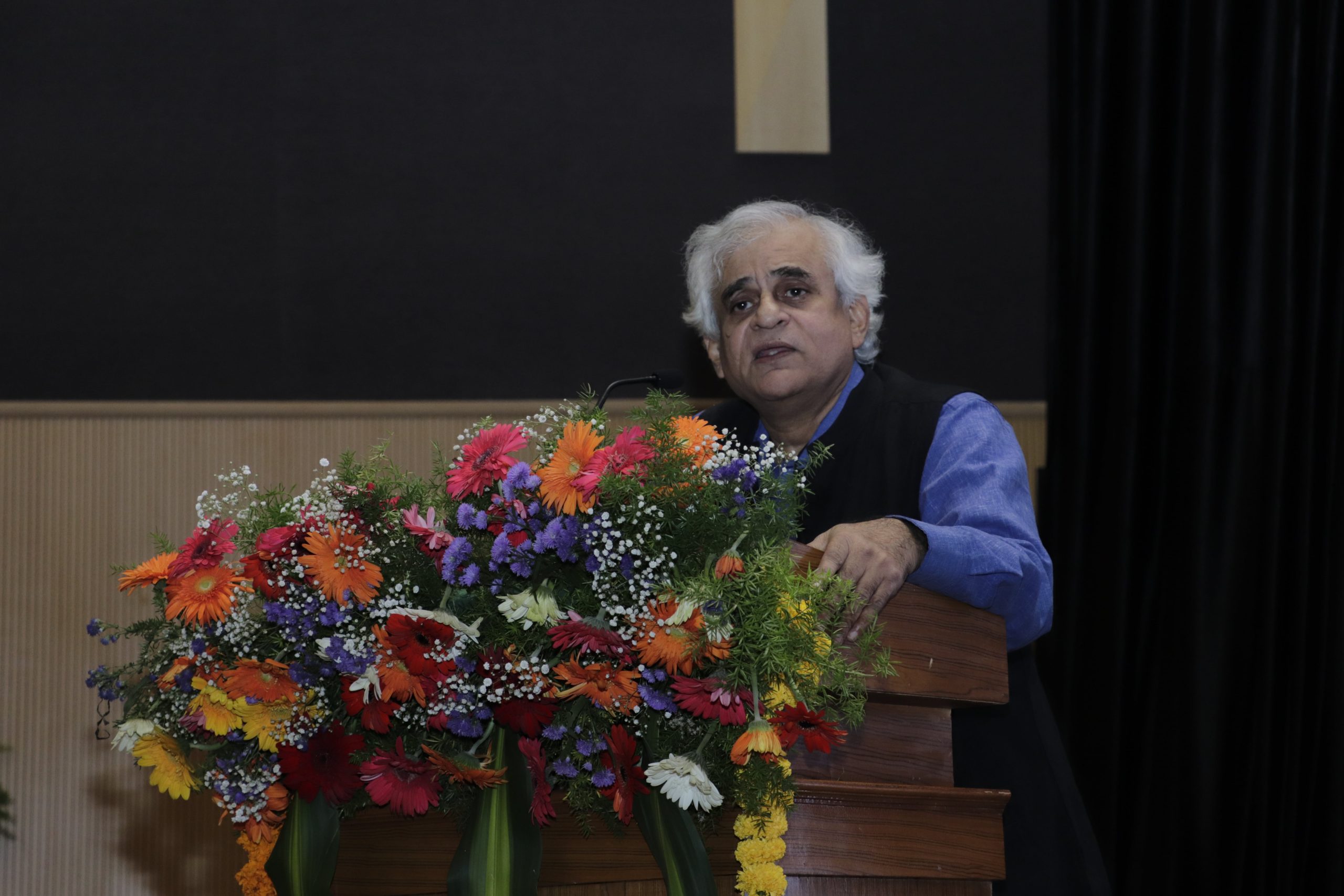 Eminent Columnist P Sainath addressed the gathering of scientists and researchers from various parts of the country in the Public Lecture Telling the stories of rural Indians in the digital age: The People’s Archive of Rural India. The lecture was organised as a part of the 88th Annual Meeting of the Indian Academy of Sciences at SRM University-AP, Andhra Pradesh.
Eminent Columnist P Sainath addressed the gathering of scientists and researchers from various parts of the country in the Public Lecture Telling the stories of rural Indians in the digital age: The People’s Archive of Rural India. The lecture was organised as a part of the 88th Annual Meeting of the Indian Academy of Sciences at SRM University-AP, Andhra Pradesh.
P Sainath talked about the People’s Archive of Rural India (PARI), which brings together science, technology, culture and literature. PARI is a free digital space wholly dedicated to rural India, publishing in 14 languages in India with a huge volunteer force of translators. Though rural India accounts for 69% of the total population of India, their representation in the frontier of national dailies are limited to a meagre total of 0.67 percent. P Sainath commented on this ostracization by calling out the tainted and prejudiced rationale of media houses on neglecting rural life as they offered no credible revenue for their media coverage.
Mr Sainath also talked about the content of his upcoming book The Last Heroes: Foot Soldiers of Indian Freedom expressing that, “It is a gigantic tragedy that this generation and the coming generation won’t be seeing our freedom fighters”. He further talked about the alarming status of India in the environmental performance index and global hunger index and the need to address the agrarian crisis and the growing digital divide in society. “Equitable distribution of opportunities paramount to the democratisation of digital content “, affirmed P Sainath as a concern about online education. IASc President Prof. Umesh Waghmare thanked Mr P Sainath for sensitising the scientific community about the pertinent issues around them.
- Published in News, University Event
Aloha 2022: The magnificent fresher’s day celebration at SRM AP
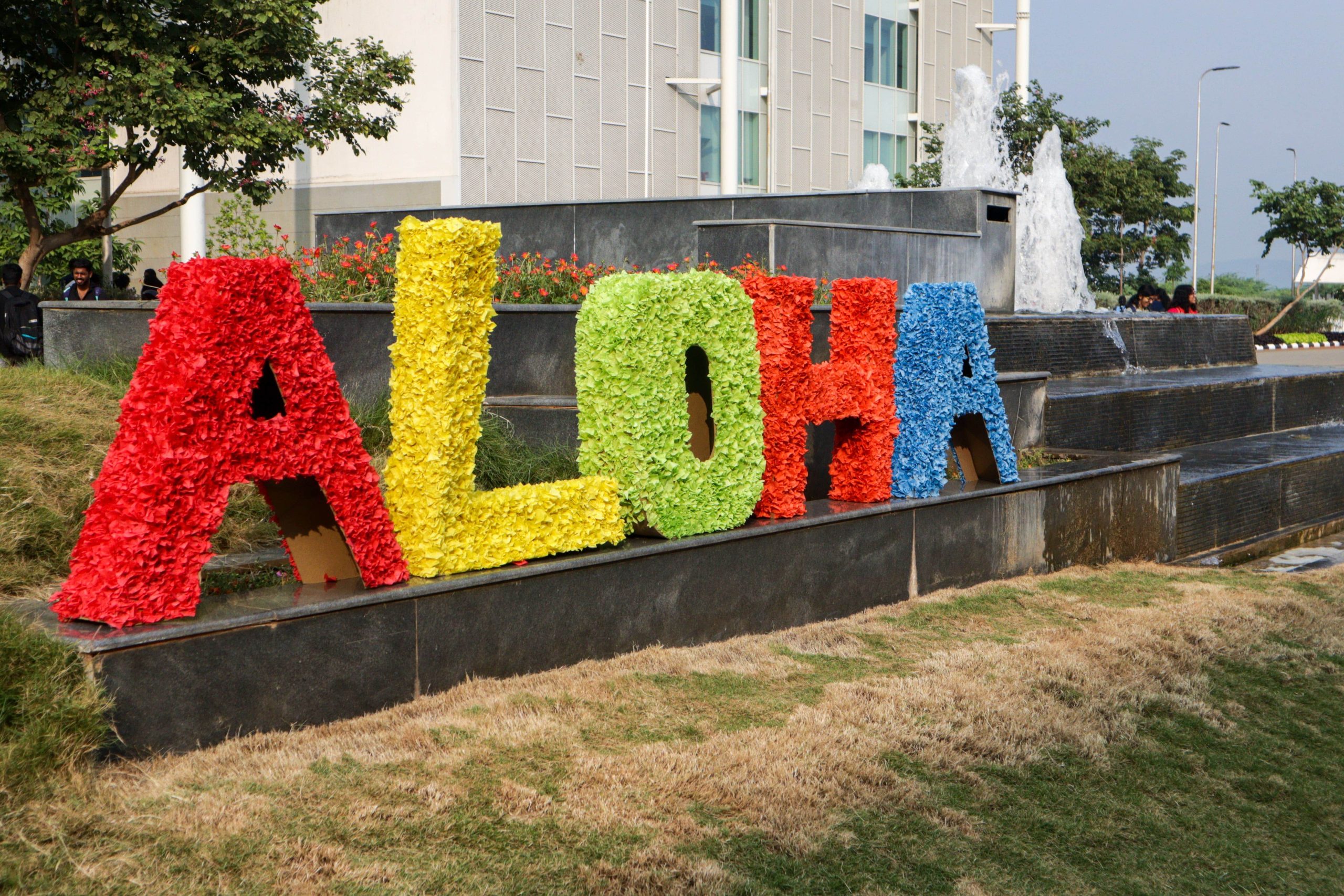 Senior students of SRM University-AP received the newcomers with a grand welcome party on November 25 and 26, 2022. The two-day-long celebrations were immaculate and encapsulated the radiant aura of the new-age university.
Senior students of SRM University-AP received the newcomers with a grand welcome party on November 25 and 26, 2022. The two-day-long celebrations were immaculate and encapsulated the radiant aura of the new-age university.
Enthralling games, incredible performances, mouth-watering food stalls, booming music, and the brightest grins precisely describe Aloha 2022, the fresher’s day celebrations. Newcomers were welcomed to the festivity of SRM AP with the warmest colours and loudest cheers!
Honourable Vice Chancellor of SRM University- AP, Prof Manoj K Arora, inaugurated the event and asked the students to fully revel in the celebrations. All the faculty, staff and leadership members were also present at the festive occasion to welcome the brand-new batch of students to the campus.
A wide array of entertainment programmes was organised as part of the wholesome event. Students took over the stage by dancing to hype songs and singing their hearts out on both days of the event. The highlight of the event’s second day was the Mr&Ms Freshers contest. The vibe of the fresher’s party reached its peak with the vibrant DJ party filled with loud cheers and solid beats.
Cubing context, Tug of war, crossword, pop culture quiz, bucket game, water race, and many other fun games were also arranged beside the on-stage performances, which kept the students engaged on the two days of the celebrations. The food festival featuring mouth-watering street foods added flavour to the already colourful festival.
- Published in student affairs news, University Event
“Glory to a Proud Nation”- 74th Republic Day Celebrations at SRM AP
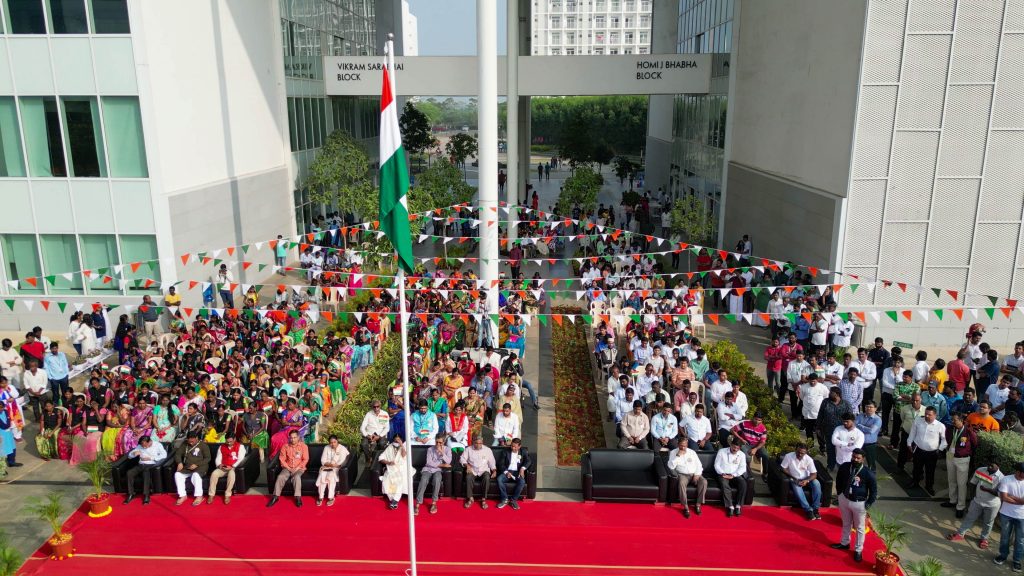
SRM University-AP celebrates the 74th Republic Day of our glorious nation with immense pride and zeal in commemorating the genesis of India’s constitution. Honourable Vice Chancellor, Prof. Manoj K Arora initiated the auspicious event by unfurling the flag, proceeding with the National Anthem and March Past. He explicated the significance of paying homage to our great nation and our brave leaders whose vigilance and valour contributed to forming a secular and republic country.
“India, since its inception as an independent, democratic nation, has advanced to the forefront of the global community as a rising influential power in the domains of science and technology, economics, democratic polity and the thriving Research and Development sector. Our constitution gives us the responsibility, rights, and resources to work towards the growth of our nation. SRM University-AP aligns itself with India’s vision, providing an innovative research-oriented ecosystem for cutting-edge research and entrepreneurial learning that works in tandem with the holistic growth of the country.” said Prof Arora in his commemorative speech.
On this proud occasion, SRM AP honoured its dedicated staff and faculty who have rendered their faithful service to the university’s cause and holistic development for the past five years. Honourable Vice Chancellor felicitated the programme and awarded mementoes and certificates to the recipients for their dedicated commitment to the institute. Laurels were also presented to the winners and champions for their remarkable achievements in their respective fields at the event. Cultural programmes by the students contributed to the joyous Republic Day celebration of our rich and valiant nation.
- Published in News, University Event
Makar Sankranti at SRM AP – A Delightful Celebration!
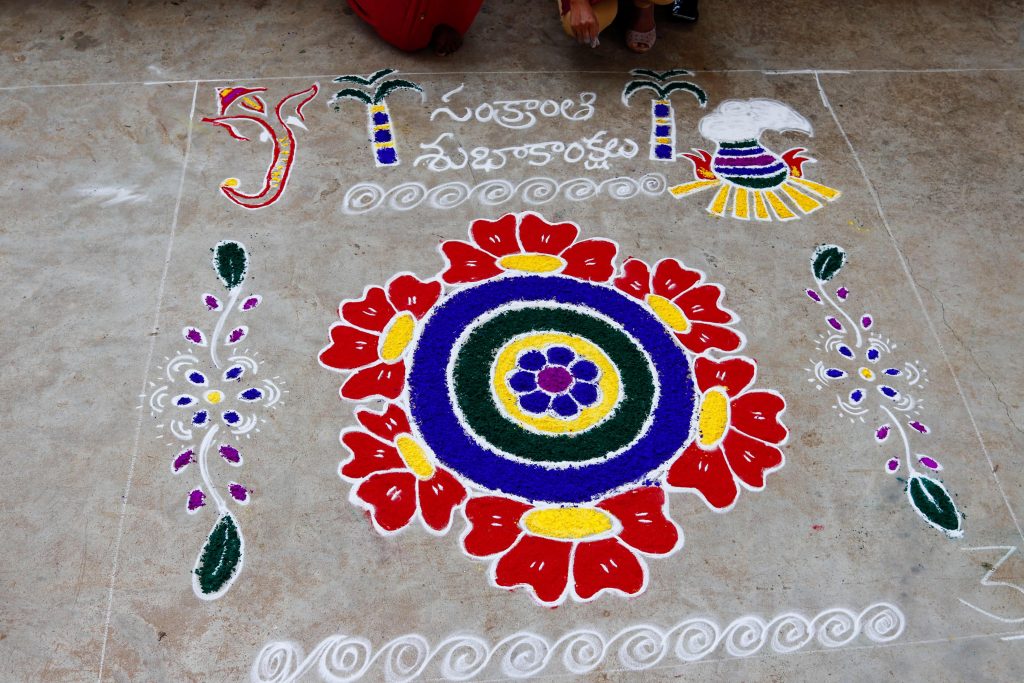
The year’s harvest festival was celebrated with great exuberance and ecstasy by the faculty, staff and students of SRM AP. All festivities were up in the air when all in the academic and non-academic community were adorned in their ethnic wear and came together to represent and celebrate the traditions and honour our heritage.
The Makar Sankranti/Pongal celebrations comprise various games and activities that best showcase the creative skills of the participants. The Rangoli Making contest was one of the highlights of the celebration. Rangoli, being an essential mark of celebrating festivities, is drawn in different states with different names and on different themes. Muggu in Andhra Pradesh, Kolam in Tamil Nadu, Sathiya in Gujarat, Alpana in Bengal, Mandana in Rajasthan, Osa in Odisha, Aipan in Uttarakhand, or simply the Rangoli from Maharashtra – every region has its unique way of representing their traditions, folklore and practices.
A thrilling pot-breaking contest, cup stacking contest and an adrenaline-driven tug-of-war saw active participation from our Indian and international students who were fascinated by our cultural representations and immersed themselves in various competitions. To create awareness about the nutritional value of food cooked without flame, the necessity and advantages of healthy eating and to encourage people to stay away from junk food, a Cooking without Fire/Induction contest was held.
- Published in News, University Event
AMEYA 2k23: The Signature B-School Fest at SRM University-AP
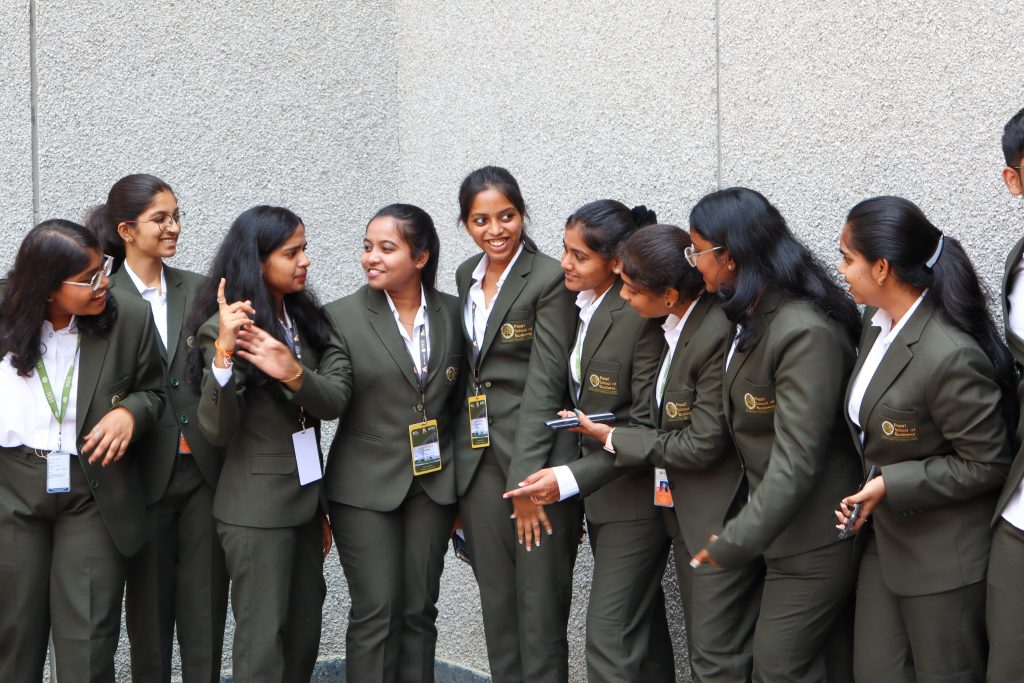
The Paari School of Business organised the very first edition of its signature Business Fest “AMEYA 2k23” on April 12 and 13, 2023, at SRM University-AP, Andhra Pradesh. The EMBA programme was also launched during this event. The event was inaugurated on April 12 by Chief Guest, Dr Nagendra V Chowdary in the presence of the Vice Chancellor, Prof. Manoj K Arora; Registrar, Dr R Premkumar; Dean-Paari School of Business, Prof. Bharadwaj Sivakumaran.
The event was launched on a great scale with events being conducted both from the technical as well as non-technical streams. Students from other educational institutions enthusiastically participated in the fest. Technical events such as How’s That (IPL Auction) and Big Bull (Stock Market Simulation), created interest among the participants. There were events from every parallel offered as specialisations by the B-School. A few other events that were conducted are Resultyics, Get Massive Votes, Mock Commercial, Brand Race, and sustainability concept-based Upcycling.
The non-technical events induced a fun and healthy competitive atmosphere in the university. Events like hopscotch, treasure hunt, and separation anxiety had pulled large crowds. The organising committee also encouraged student entrepreneurship by allowing the students to set up food and game stalls.
The business fest concluded on a high note by rewarding the winners from all the events. The winners were given cash prizes of Rs. 5000 and Rs. 3000 for 1st and 2nd place, respectively. Two movie promotions were organised as part of AMEYA 2k23. The film crew and cast of Anni Manchi Sekunalu visited the campus on April 12, adding entertainment and excitement to the already buzzing fest. Team Ugram were a part of the cultural night on April 13. The event was concluded by dance performances, beatboxing and a spectacular DJ night. AMEYA 2k23 was a grand success and a trademark event in the history of the Paari School of Business.
- Published in Departmental News, News, Paari Current Happenings, University Event


